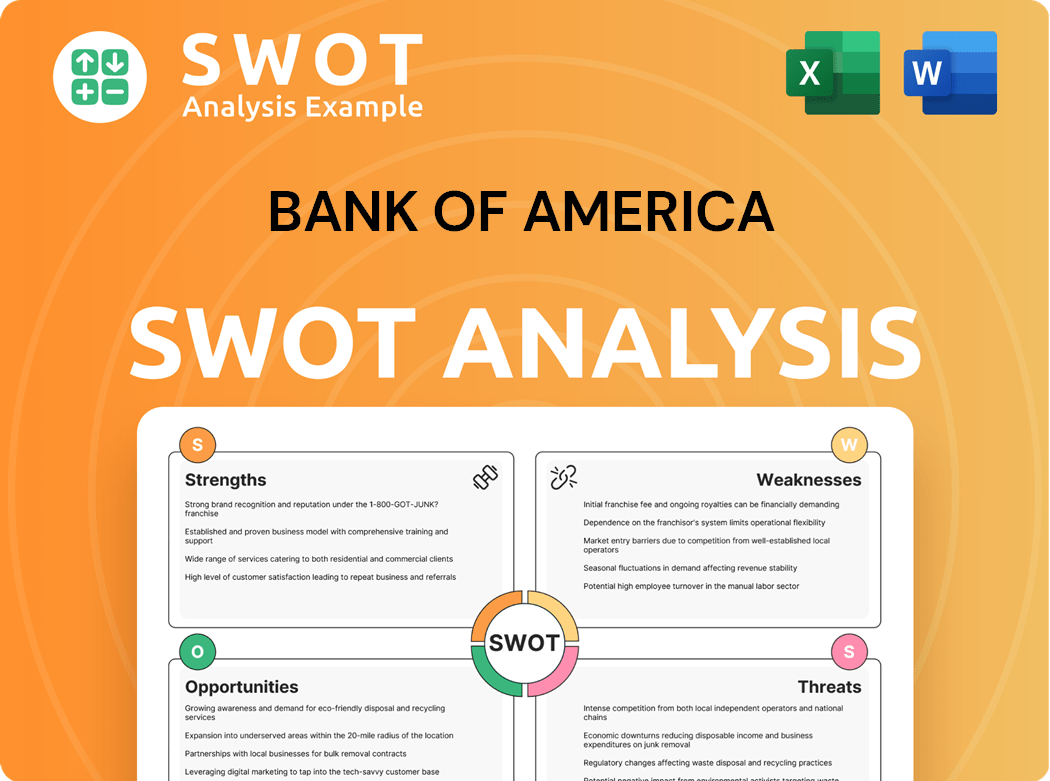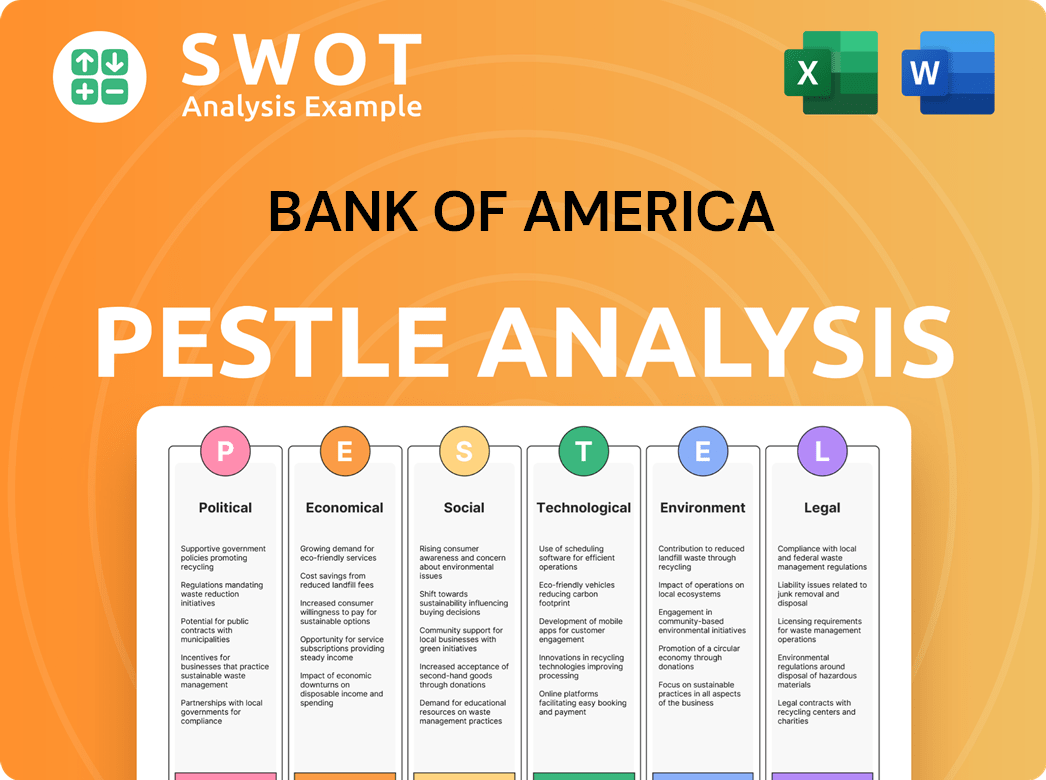Bank of America Bundle
How Does Bank of America Stack Up in Today's Banking Battleground?
The Bank of America SWOT Analysis reveals a financial titan navigating a fiercely contested landscape. The financial services industry is undergoing a massive transformation, and understanding the competitive dynamics surrounding Bank of America is crucial for any investor or strategist. This exploration delves into the key players vying for market dominance, providing a detailed look at BofA's position within the banking sector.

This analysis provides a comprehensive look at the Bank of America competitive landscape, examining its main rivals and assessing its competitive advantage. We'll dissect the strategies employed by Bank of America's competitors, offering a clear view of the challenges and opportunities facing BofA in the current market. This in-depth banking sector analysis will help you understand Bank of America's market share compared to competitors and its overall performance.
Where Does Bank of America’ Stand in the Current Market?
Bank of America (BofA) maintains a prominent market position within the global financial services industry. As of early 2025, it stands as one of the largest banks in the United States by assets, demonstrating a significant market share across various segments. Its core operations encompass consumer banking, global wealth and investment management, global banking, and global markets, providing a wide array of services to a diverse customer base.
The company's value proposition centers on delivering comprehensive financial solutions, leveraging a vast network and digital platforms. This approach aims to enhance customer experience and operational efficiency. BofA's strategic focus includes digital transformation and diversification into investment and wealth management, aiming to strengthen its competitive position. This is a key element of the Marketing Strategy of Bank of America.
Geographically, BofA's primary focus is the U.S. market, where it has a strong presence with financial centers and ATMs. Its global banking and global markets segments extend its reach internationally. BofA's ability to navigate competitive pressures from fintech firms and regional banks is crucial for its continued success.
BofA holds a substantial share of the U.S. retail banking market. Its consumer banking segment provides services like checking and savings accounts, credit cards, and mortgage products. This segment is a key driver of the company's overall market share.
The Global Wealth & Investment Management segment, including Merrill and Bank of America Private Bank, demonstrates leadership in wealth management and advisory services. This segment caters to high-net-worth individuals and institutions, contributing significantly to the company's revenue and market position.
BofA has strategically emphasized digital transformation to enhance customer experience and improve operational efficiency. This has involved significant investments in digital platforms and technologies. These initiatives are crucial for competing effectively with fintech innovators.
For the first quarter of 2024, BofA reported a net income of $6.7 billion and diluted earnings per share of $0.76. This financial health and scale compare favorably to industry averages, reflecting its robust capital position and diversified revenue streams. This demonstrates the company's financial strength and ability to generate profits.
BofA's competitive advantages include its extensive branch network, robust digital banking platform, and diversified service offerings. These factors contribute to its strong market position and ability to attract and retain customers. The company's focus on innovation and customer service further strengthens its competitive edge.
- Extensive Branch Network: Provides accessibility and convenience for customers.
- Robust Digital Banking Platform: Enhances customer experience and operational efficiency.
- Diversified Service Offerings: Includes consumer banking, wealth management, and global markets.
- Strong Financial Performance: Demonstrates profitability and financial stability.
Bank of America SWOT Analysis
- Complete SWOT Breakdown
- Fully Customizable
- Editable in Excel & Word
- Professional Formatting
- Investor-Ready Format

Who Are the Main Competitors Challenging Bank of America?
The Bank of America competitive landscape is shaped by a diverse group of financial institutions and emerging fintech companies. This dynamic environment requires the company to constantly adapt its strategies to maintain and grow its market share. Understanding its competitors is crucial for BofA market analysis and strategic planning.
Bank of America's ability to navigate this competitive terrain depends on its strengths, innovation, and strategic responses to both traditional and new market entrants. The financial services industry is constantly evolving, and Bank of America must remain agile to stay ahead.
The 'Big Four' banks, including JPMorgan Chase & Co., Wells Fargo & Company, and Citigroup Inc., are Bank of America's most significant direct competitors. These institutions compete across various segments such as investment banking, retail banking, and global markets. They often challenge Bank of America for market share in key areas.
U.S. Bancorp and PNC Financial Services Group are major regional players that compete with Bank of America, particularly in consumer and commercial banking. In wealth management, Morgan Stanley and Goldman Sachs offer specialized services to high-net-worth individuals and institutions. These specialized competitors pose a significant challenge.
Fintech companies like Chime and SoFi are disrupting the traditional banking model with digital-first approaches. Tech giants such as Apple and Google are also entering the financial services space, offering payment solutions and other products. These firms present both direct and indirect competitive threats.
Mergers and alliances continually reshape the competitive dynamics within the banking sector analysis. Regional bank mergers can create stronger competitors, intensifying competition in specific markets. These strategic moves can significantly impact the competitive landscape.
Intense competition for market share is evident in product categories like mortgage originations and credit card balances. Aggressive marketing and pricing strategies are common among major players. Bank of America's success depends on its ability to compete effectively in these areas.
Bank of America's market share is constantly challenged by its competitors. The company’s position in the US banking market is influenced by its ability to innovate and adapt. The competitive environment demands continuous improvement and strategic foresight.
To maintain its position, Bank of America must focus on its competitive advantage. A key aspect of this is understanding its strengths and weaknesses compared to rivals. For further insights into Bank of America's growth strategies, consider reading the Growth Strategy of Bank of America.
Several factors influence the competitive landscape, including technological innovation, customer service, and financial performance. Bank of America's ability to innovate and adapt to changing market conditions is crucial for its success.
- Digital Banking: The rise of digital banking platforms has intensified competition. Bank of America's digital banking competitors include fintech firms and other large banks with advanced online services.
- Customer Service: Customer service quality is a key differentiator. Comparisons of Bank of America's customer service with competitors reveal areas for improvement and opportunities for differentiation.
- Financial Performance: Bank of America's financial performance is constantly measured against its competitors. Analyzing its financial results, such as revenue, profit margins, and return on equity, provides insight into its competitive standing.
- Expansion Strategies: Bank of America's expansion strategies and competitive threats are closely linked. The company must carefully consider market dynamics and potential challenges when entering new markets or expanding its product offerings.
- Innovation: Bank of America's innovation in the banking sector, including new products and services, is essential for maintaining a competitive edge.
Bank of America PESTLE Analysis
- Covers All 6 PESTLE Categories
- No Research Needed – Save Hours of Work
- Built by Experts, Trusted by Consultants
- Instant Download, Ready to Use
- 100% Editable, Fully Customizable

What Gives Bank of America a Competitive Edge Over Its Rivals?
The competitive landscape for Bank of America is shaped by its substantial brand recognition and customer loyalty, a legacy built over decades. This trust translates into a stable customer base, a key advantage in the financial services industry. The bank's extensive distribution network, including thousands of physical branches and ATMs across the United States, provides a tangible presence that many digital-only competitors lack. This physical infrastructure complements its digital offerings, creating a hybrid model that appeals to a broad range of customers.
Bank of America's competitive edge is also significantly influenced by its economies of scale. As one of the largest financial institutions globally, it leverages its size to achieve cost efficiencies in operations, technology, and regulatory compliance. This scale allows for substantial investments in proprietary technologies and digital platforms, such as its mobile banking app and AI-powered virtual assistant, Erica. These technological advancements enhance customer experience and streamline internal processes, providing a competitive advantage in the banking sector analysis.
Furthermore, the bank's diversified business model across consumer banking, wealth management, global banking, and global markets provides inherent stability. This diversification mitigates risks associated with fluctuations in any single market segment and allows for cross-selling opportunities, maximizing revenue per customer. The company's strong talent pool, particularly in specialized areas like investment banking and wealth management through Merrill, also contributes to its competitive edge by providing expert advice and tailored solutions to clients. Understanding the Target Market of Bank of America is crucial to understanding its competitive strategy.
Bank of America benefits from decades of consumer recognition and trust. This strong brand equity translates into a loyal customer base, providing a stable foundation. This advantage is crucial in a competitive market where customer retention is key.
The bank's vast network of branches and ATMs across the U.S. offers a tangible presence. This physical infrastructure complements its digital platforms, enhancing customer accessibility. This extensive network is a key differentiator compared to digital-only competitors.
As one of the largest banks globally, Bank of America achieves significant cost efficiencies. This scale allows for substantial investment in technology and innovation. These economies of scale contribute to its competitive advantage.
Bank of America operates across consumer banking, wealth management, and global markets. This diversification mitigates risks and allows for cross-selling opportunities. This strategy provides inherent stability in the face of market fluctuations.
Bank of America's competitive advantages include strong brand recognition, a vast distribution network, economies of scale, and a diversified business model. These strengths are supported by ongoing investments in technology and a focus on personalized customer experiences. These factors position the bank favorably in the financial services industry.
- Brand Recognition: Decades of trust and customer loyalty.
- Extensive Network: Thousands of branches and ATMs across the U.S.
- Economies of Scale: Cost efficiencies and investment in technology.
- Diversified Business: Stability across various market segments.
Bank of America Business Model Canvas
- Complete 9-Block Business Model Canvas
- Effortlessly Communicate Your Business Strategy
- Investor-Ready BMC Format
- 100% Editable and Customizable
- Clear and Structured Layout

What Industry Trends Are Reshaping Bank of America’s Competitive Landscape?
The Bank of America competitive landscape is currently shaped by rapid technological advancements, evolving regulatory frameworks, and shifts in consumer behavior. The financial services industry is experiencing significant disruption from fintech companies and changing economic conditions. Understanding these trends is crucial for BofA market analysis and maintaining a strong position in the market. For a deeper dive into the company's origins, you can explore the Brief History of Bank of America.
The future outlook for Bank of America involves navigating these challenges while capitalizing on emerging opportunities. Strategic initiatives focused on digital transformation, customer-centric solutions, and global expansion are key to sustaining growth and profitability. The company must also address risks related to cybersecurity, economic volatility, and increased competition to maintain its competitive edge.
The banking sector analysis reveals key trends such as the increasing adoption of AI and machine learning in financial services. There's also a growing emphasis on digital-first solutions and personalized customer experiences. Regulatory changes, including those around data privacy, are also significantly impacting the industry.
Bank of America's competitors include fintech disruptors and established financial institutions, creating intense competition. The bank faces challenges from increased regulatory burdens and the potential for cyberattacks. Economic factors like inflation and interest rate fluctuations also present risks.
Opportunities for competitive advantage Bank of America include expansion into emerging markets and product innovation. The company can leverage strategic partnerships and focus on ESG-focused financial products. Digital payment solutions and personalized investment platforms are also avenues for growth.
Bank of America is focusing on digital innovation, responsible growth, and a client-centric approach. The company is investing in technology and expanding its global footprint. These initiatives are designed to enhance its competitive position and adapt to changing market dynamics.
Bank of America's market share compared to competitors is a key metric for evaluating its performance. Who are Bank of America's biggest competitors 2024? JPMorgan Chase, Wells Fargo, and Citigroup remain significant rivals. Bank of America's strengths and weaknesses compared to rivals are assessed through a Bank of America SWOT analysis competitors.
- Bank of America's position in the US banking market is strong, with a significant presence in retail and commercial banking.
- Bank of America's global competitive environment includes international expansion strategies.
- Bank of America's innovation in the banking sector involves digital banking initiatives and technological advancements.
- Bank of America's digital banking competitors include fintech firms offering specialized services.
Bank of America Porter's Five Forces Analysis
- Covers All 5 Competitive Forces in Detail
- Structured for Consultants, Students, and Founders
- 100% Editable in Microsoft Word & Excel
- Instant Digital Download – Use Immediately
- Compatible with Mac & PC – Fully Unlocked

Related Blogs
- What are Mission Vision & Core Values of Bank of America Company?
- What is Growth Strategy and Future Prospects of Bank of America Company?
- How Does Bank of America Company Work?
- What is Sales and Marketing Strategy of Bank of America Company?
- What is Brief History of Bank of America Company?
- Who Owns Bank of America Company?
- What is Customer Demographics and Target Market of Bank of America Company?
Disclaimer
All information, articles, and product details provided on this website are for general informational and educational purposes only. We do not claim any ownership over, nor do we intend to infringe upon, any trademarks, copyrights, logos, brand names, or other intellectual property mentioned or depicted on this site. Such intellectual property remains the property of its respective owners, and any references here are made solely for identification or informational purposes, without implying any affiliation, endorsement, or partnership.
We make no representations or warranties, express or implied, regarding the accuracy, completeness, or suitability of any content or products presented. Nothing on this website should be construed as legal, tax, investment, financial, medical, or other professional advice. In addition, no part of this site—including articles or product references—constitutes a solicitation, recommendation, endorsement, advertisement, or offer to buy or sell any securities, franchises, or other financial instruments, particularly in jurisdictions where such activity would be unlawful.
All content is of a general nature and may not address the specific circumstances of any individual or entity. It is not a substitute for professional advice or services. Any actions you take based on the information provided here are strictly at your own risk. You accept full responsibility for any decisions or outcomes arising from your use of this website and agree to release us from any liability in connection with your use of, or reliance upon, the content or products found herein.